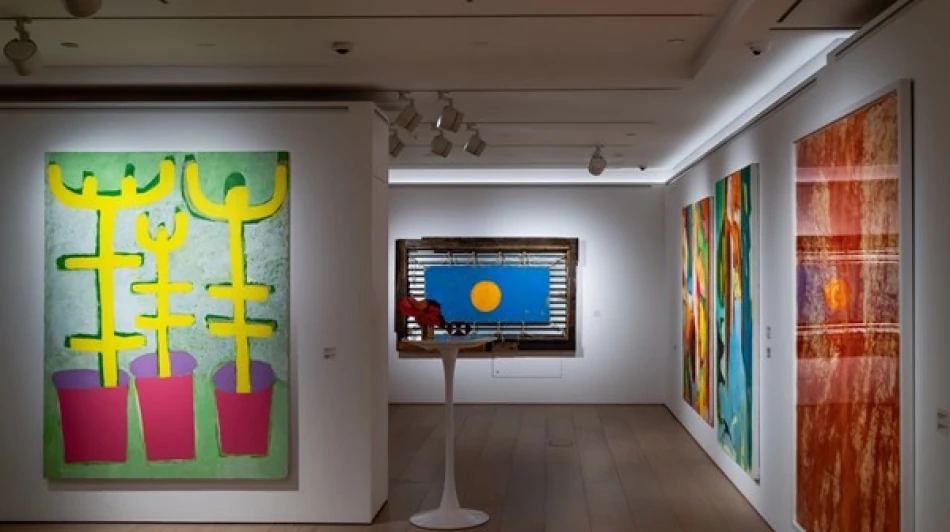
Emirati Art Shines Bright on Global Stages, Supported by HSBC and Abu Dhabi Art Fair
HSBC Bridges UAE Art Scene with Hong Kong in Strategic Cultural Diplomacy Move
HSBC's decision to showcase Emirati and Middle Eastern artists at Hong Kong's prestigious Sotheby's Maison represents more than cultural exchange—it signals a calculated strategy to strengthen economic ties between key financial hubs through soft power. The dual exhibitions, running until July 27, position the UAE as a serious player in the global creative economy while reinforcing Hong Kong's role as Asia's cultural gateway.
Two Exhibitions, One Strategic Vision
The bank's global partnership with Art Abu Dhabi has materialized into two distinct but complementary exhibitions at Sotheby's Maison. "Different Perspectives," curated by HSBC, features established international contemporary artists including Emirati masters Mohamed Kazem and Mohamed Ahmed Ibrahim alongside global names like Alvaro Barrington and Vivian Zhang. The exhibition explores identity, migration, and memory—themes that resonate strongly in both Hong Kong and the UAE as international crossroads.
The second exhibition, "Emerging Artists Horizons," commissioned by Art Abu Dhabi, spotlights the next generation of UAE and Middle Eastern creative talent, including Fatima Al Ali, Dina Nazmi Khorshid, and Samreen Mehra Agarwal. Their works span sculpture, sound, and textiles, examining transformation and emotional connections between people and place.
Cultural Diplomacy Meets Economic Strategy
This initiative reflects a broader trend among Gulf states leveraging cultural soft power to strengthen international business relationships. The UAE has been particularly aggressive in this approach, following Saudi Arabia's Vision 2030 cultural investments and Qatar's museum-building spree ahead of the 2022 World Cup.
Mohamed Abdulrahman Al Marzouqi, CEO of HSBC Middle East Limited UAE, framed the partnership as supporting the UAE's "ambitious vision to establish its position as a thriving global center for the creative economy." This aligns with the UAE's broader economic diversification strategy, where the creative sector is projected to contribute significantly to non-oil GDP growth.
Hong Kong: The Perfect Cultural Bridge
Hong Kong's selection as the venue is strategically sound. The city remains Asia's art market hub, with auction houses and galleries serving as conduits between Eastern and Western collectors. For Emirati artists, exposure in Hong Kong provides access to wealthy Asian collectors increasingly interested in Middle Eastern contemporary art—a market segment that has grown substantially since 2020.
Banking on Art: HSBC's Century-Long Investment
HSBC's art collection, dating back to 1923, now encompasses over 4,000 works—making it one of the world's largest corporate art collections. This isn't mere corporate decoration; it's a sophisticated tool for relationship building and cultural diplomacy that complements the bank's global operations.
The timing is particularly relevant as HSBC navigates complex geopolitical tensions between East and West. Cultural initiatives like this allow the bank to maintain its role as a bridge between markets while demonstrating commitment to local communities in key jurisdictions.
Market Implications and Future Outlook
For the UAE's creative economy, this exhibition represents validation of its growing international relevance. The country has invested heavily in cultural infrastructure, from the Louvre Abu Dhabi to the upcoming Guggenheim, positioning itself as the Middle East's cultural capital.
Diala Nseibeh, Director of Art Abu Dhabi, emphasized the program's role in providing "artistic mentorship and funding for producing new and ambitious works," indicating sustained investment in emerging talent development. This approach mirrors successful models in Singapore and South Korea, where government-backed cultural initiatives have created thriving creative industries.
The Broader Economic Context
The exhibition occurs as both Hong Kong and the UAE seek to maintain their positions as global financial centers amid shifting geopolitical dynamics. Cultural diplomacy provides a neutral ground for relationship building, potentially facilitating future business partnerships and investment flows between the regions.
For participating artists like Fatima Al Ali, who emphasized art as "a universal language that transcends barriers," the exposure represents career-defining opportunities. The international art market increasingly values diverse perspectives, and Middle Eastern contemporary art has shown strong appreciation in recent years.
This cultural bridge-building exercise demonstrates how financial institutions can leverage art to strengthen international relationships while supporting local creative economies—a model likely to be replicated by other global banks seeking to differentiate themselves in competitive markets.
Most Viewed News

 Layla Al Mansoori
Layla Al Mansoori






